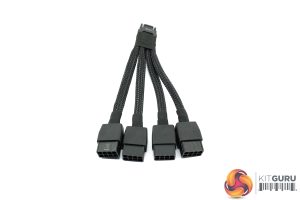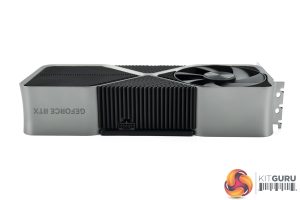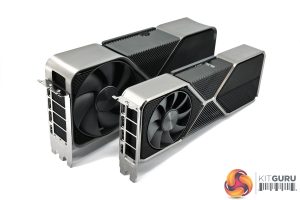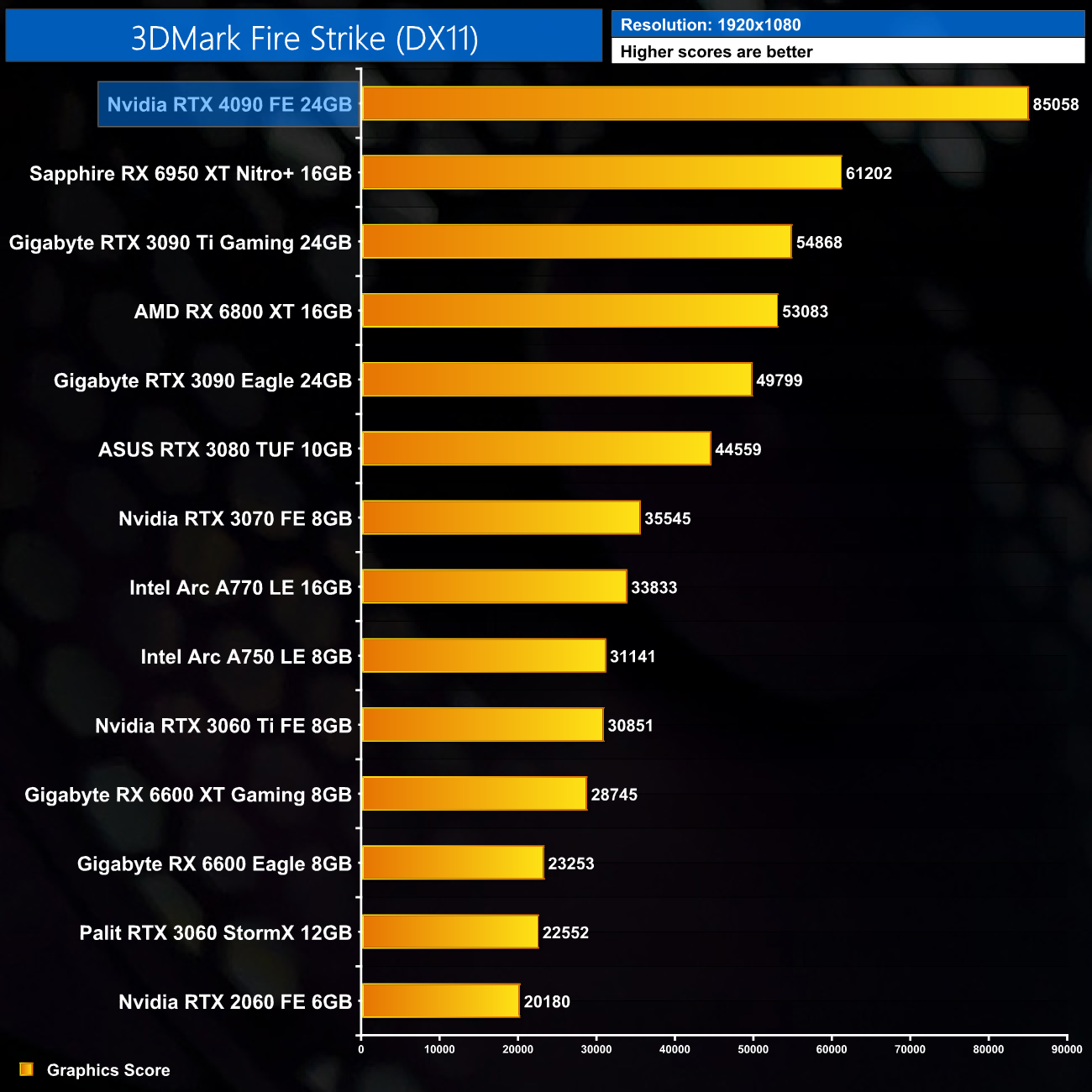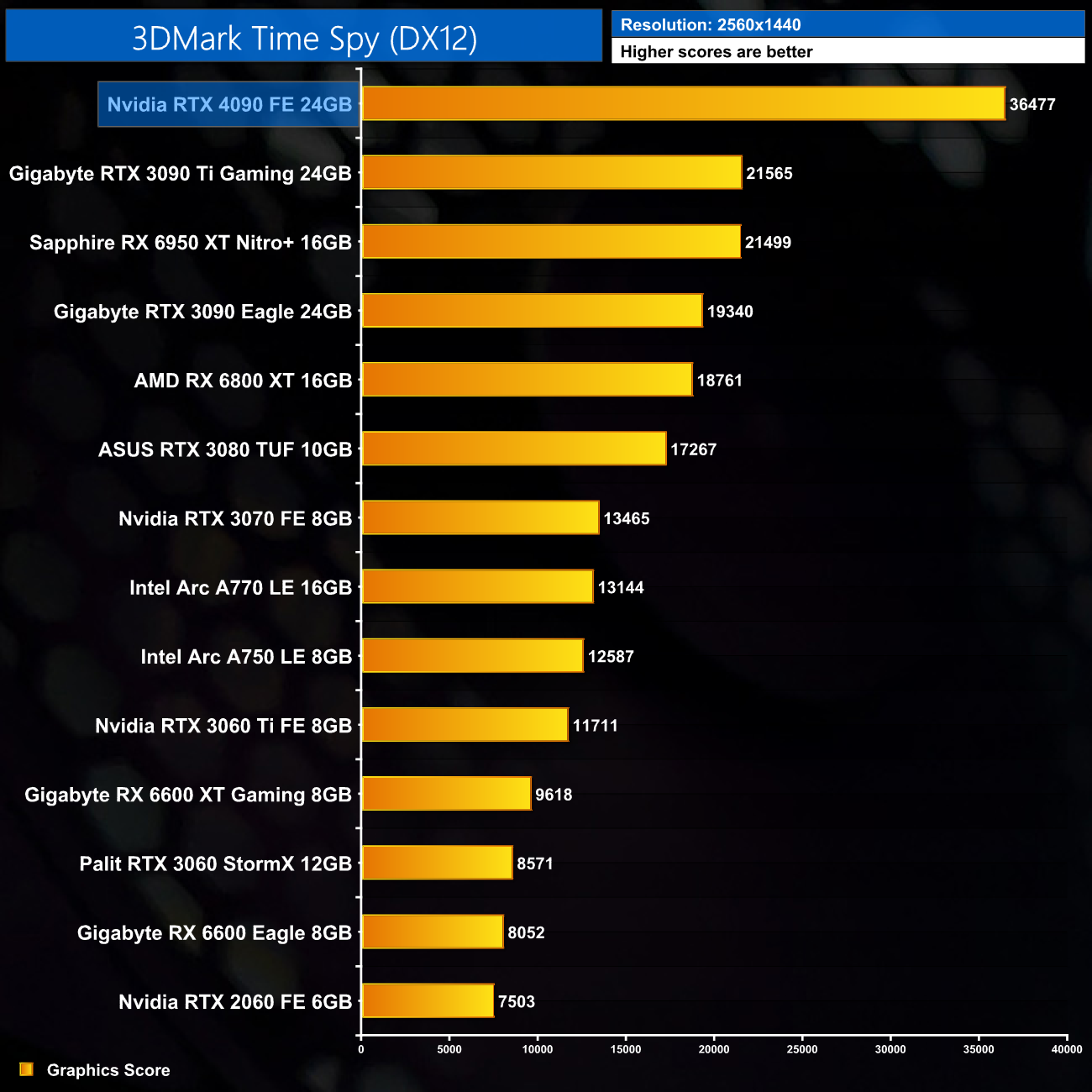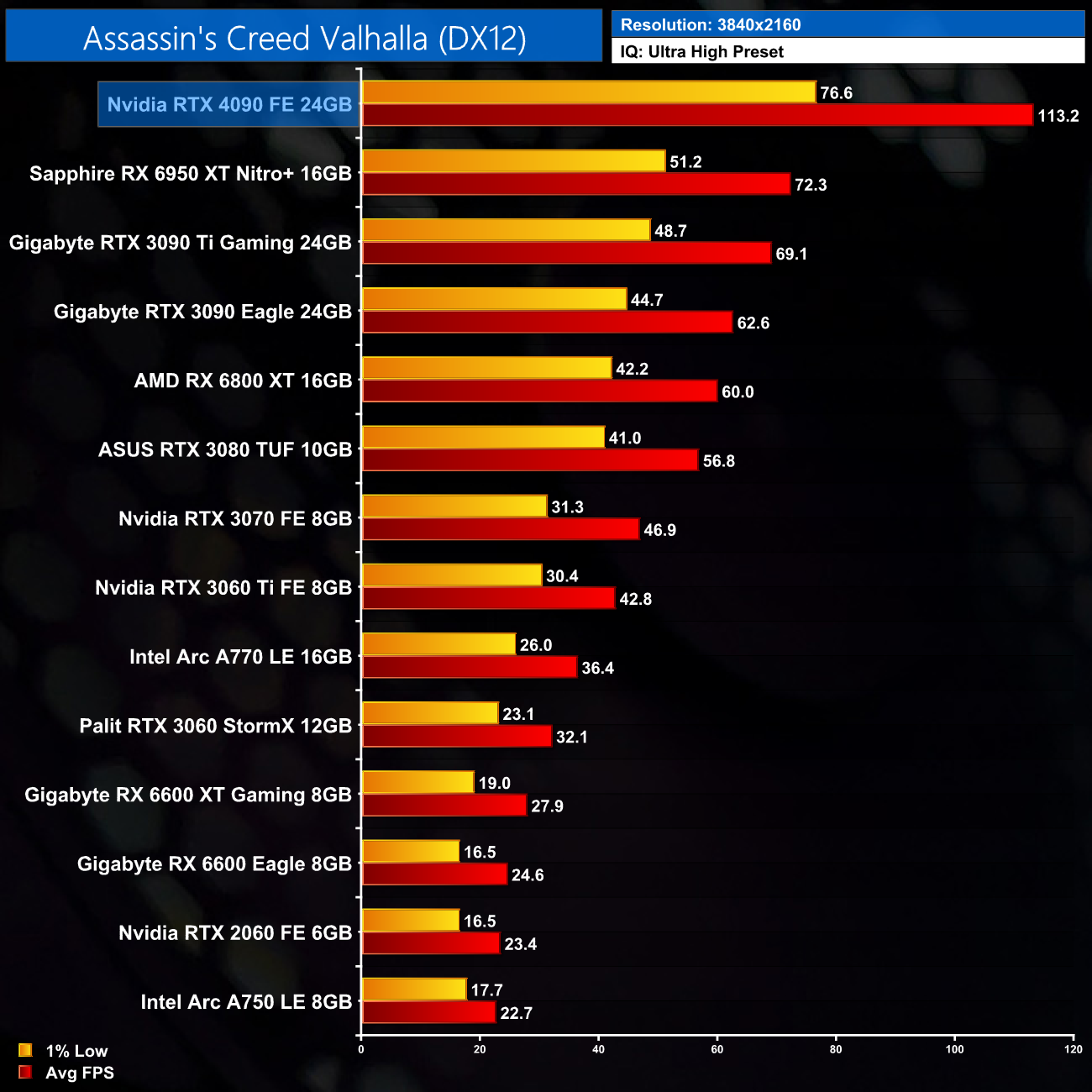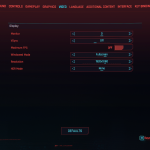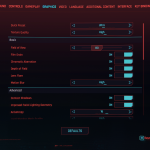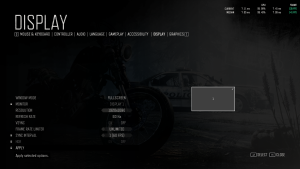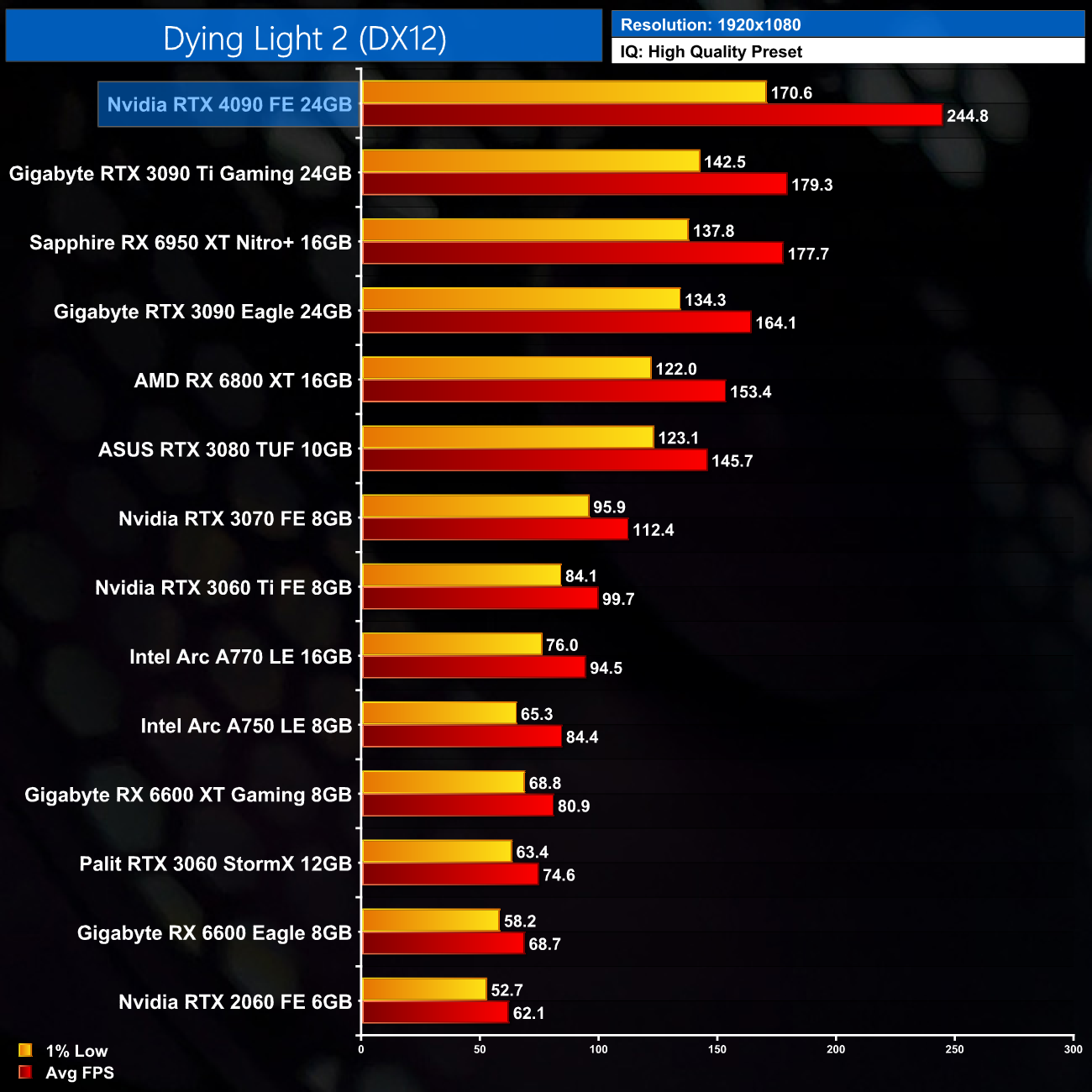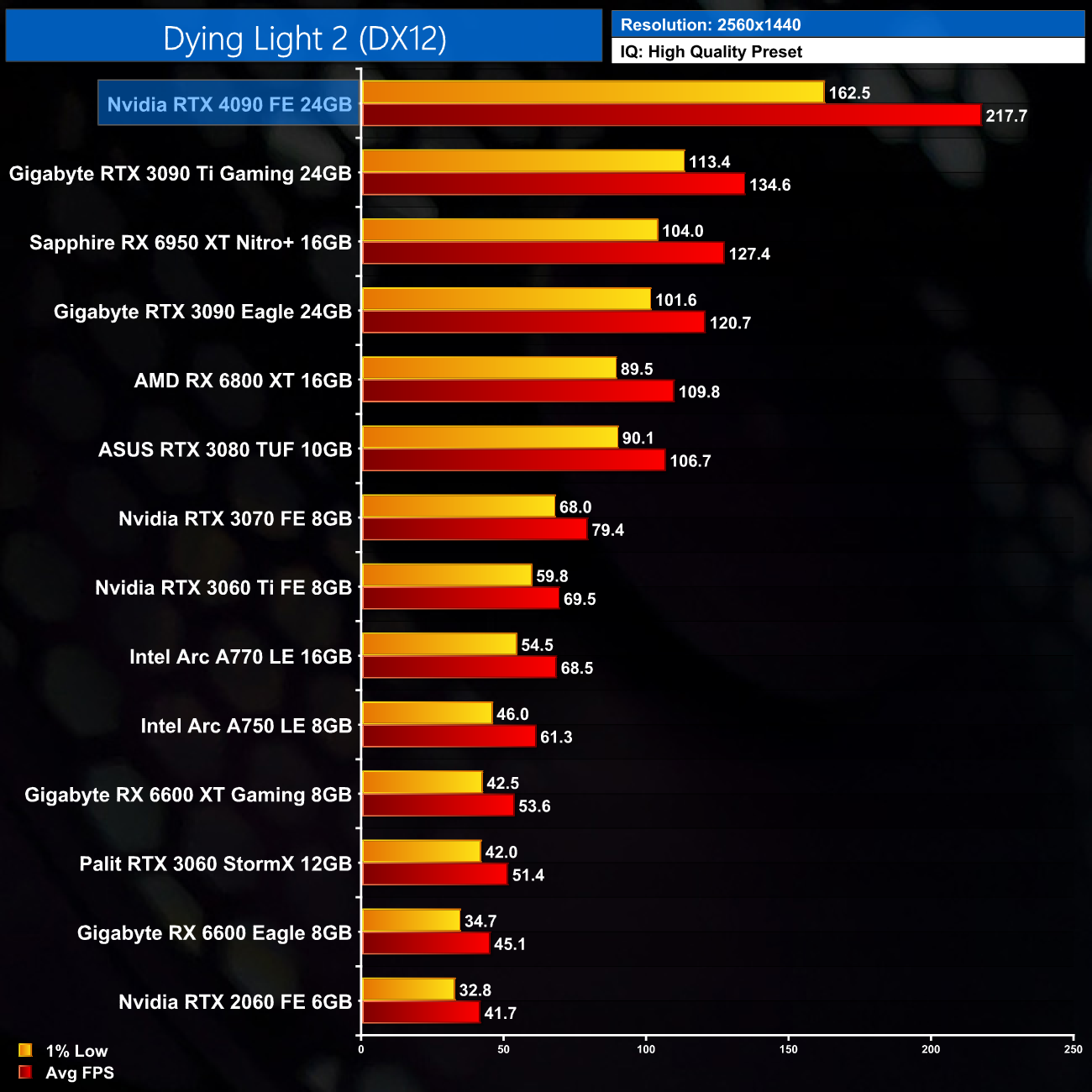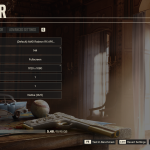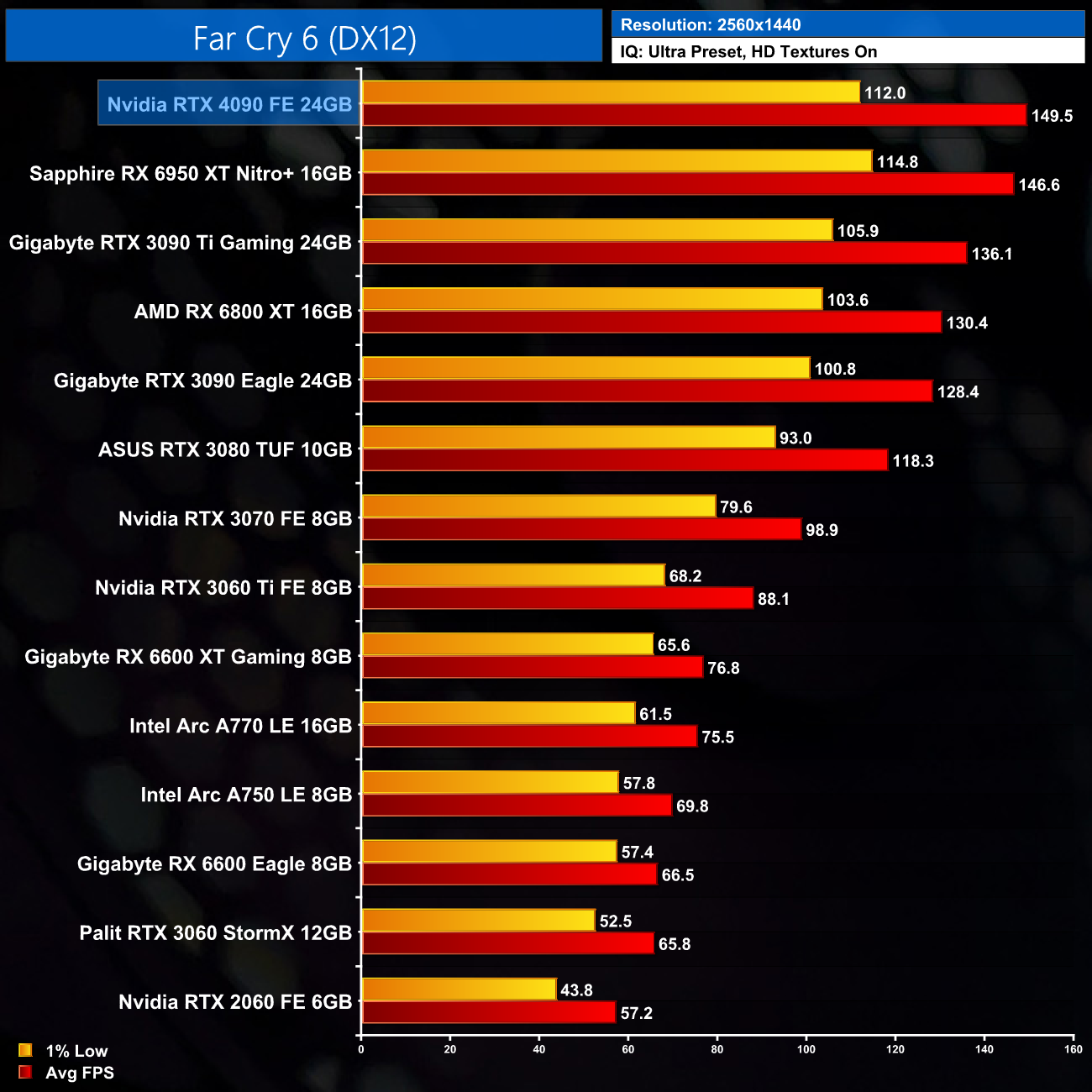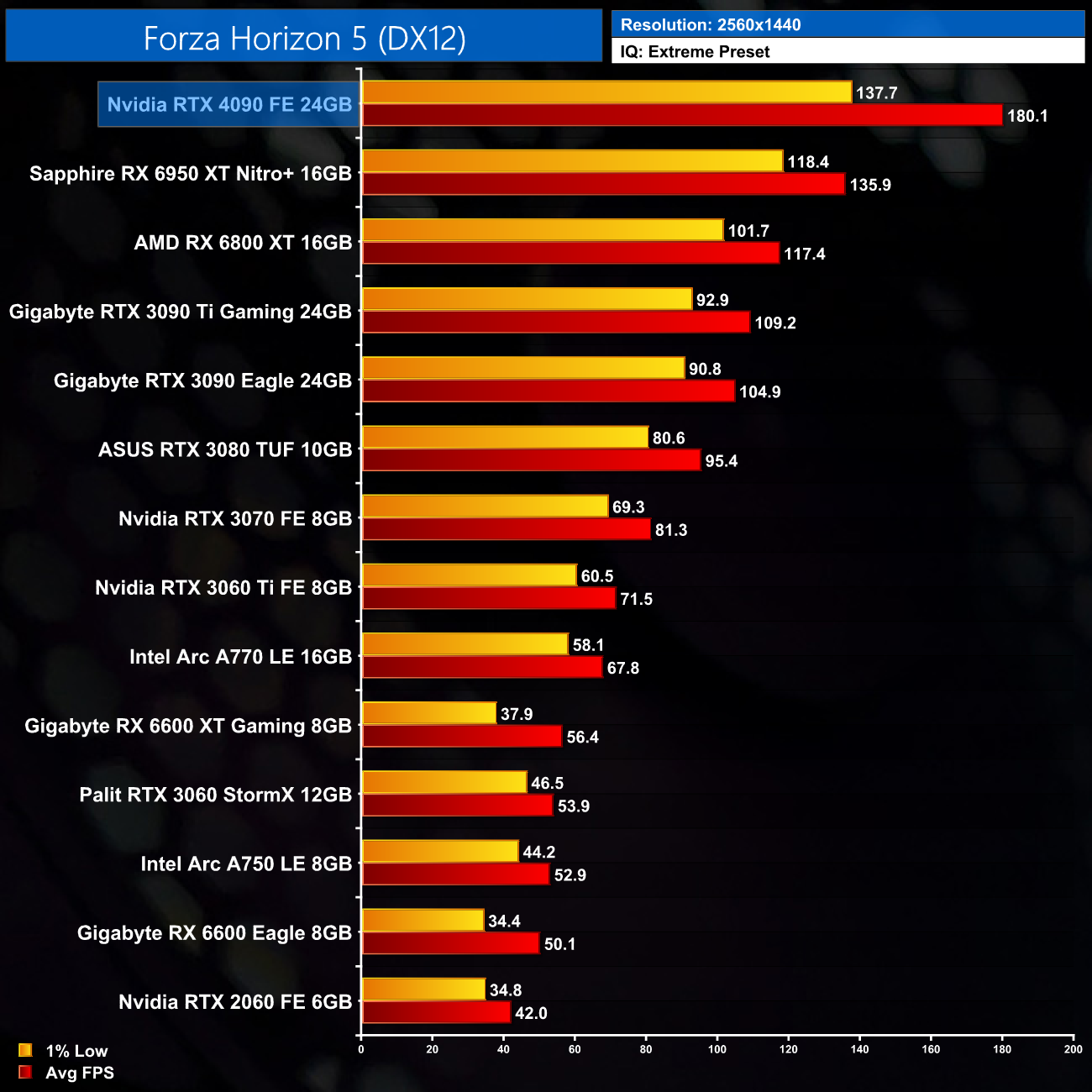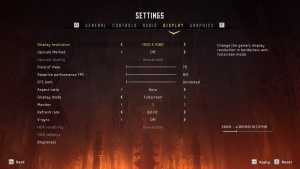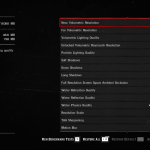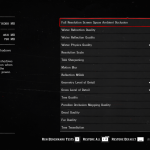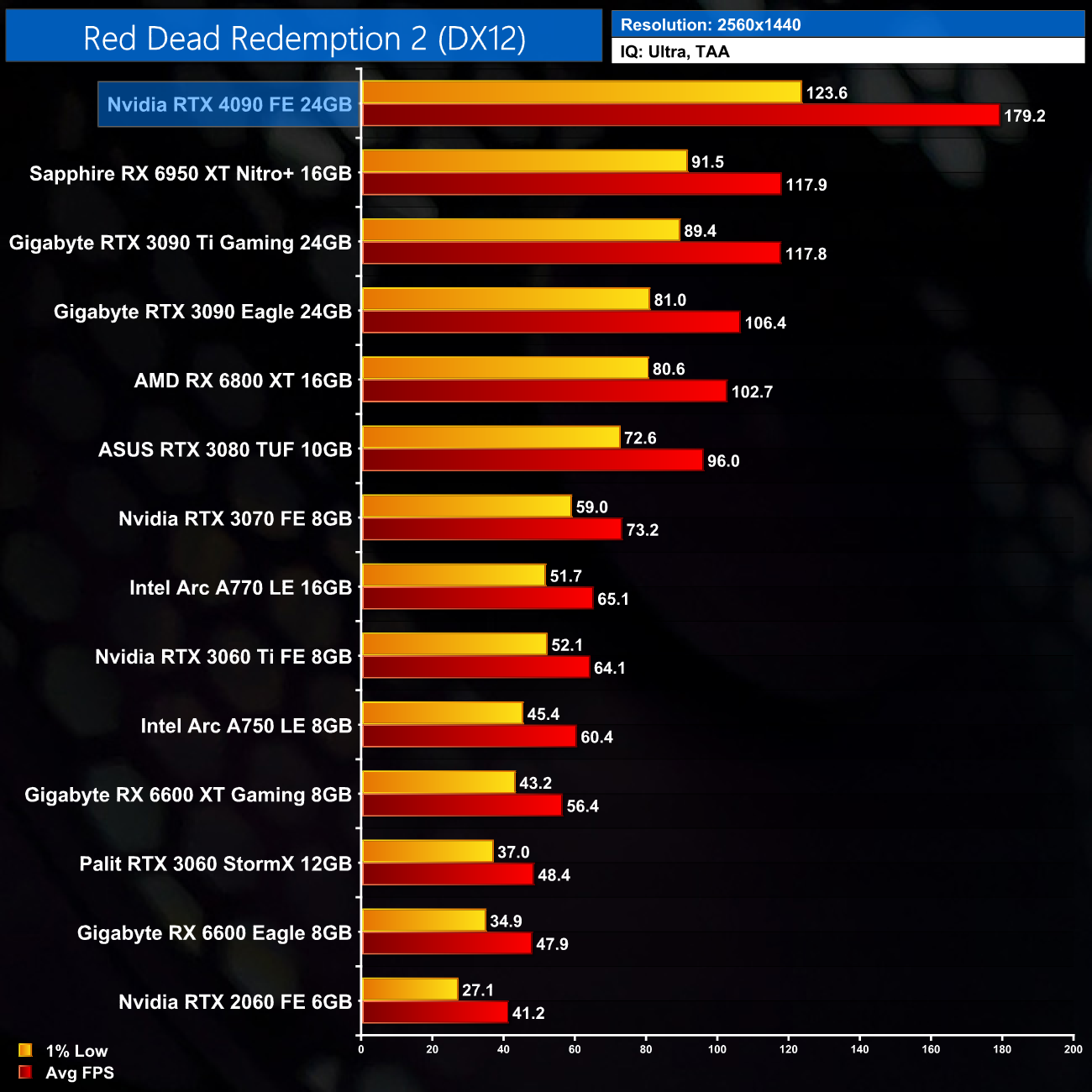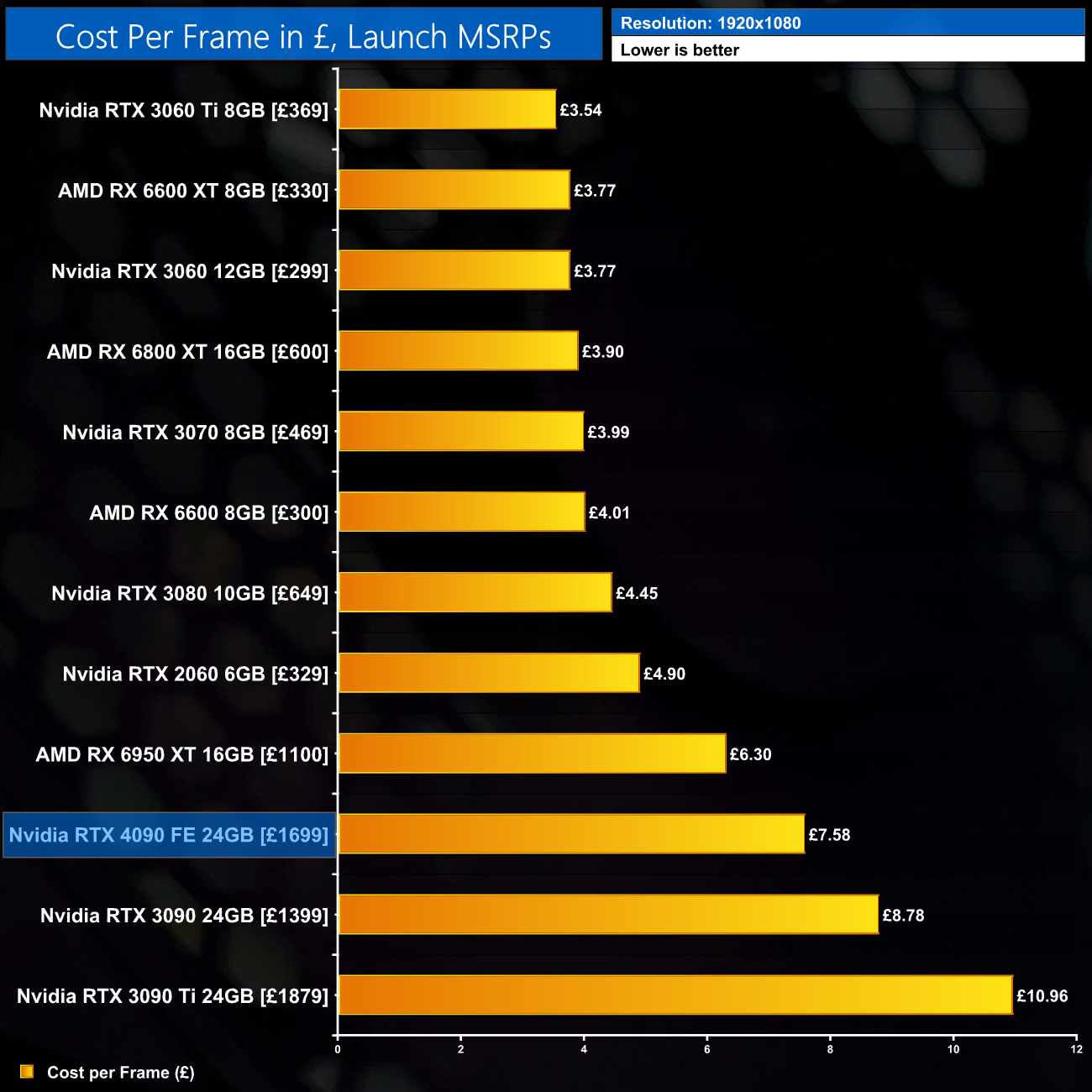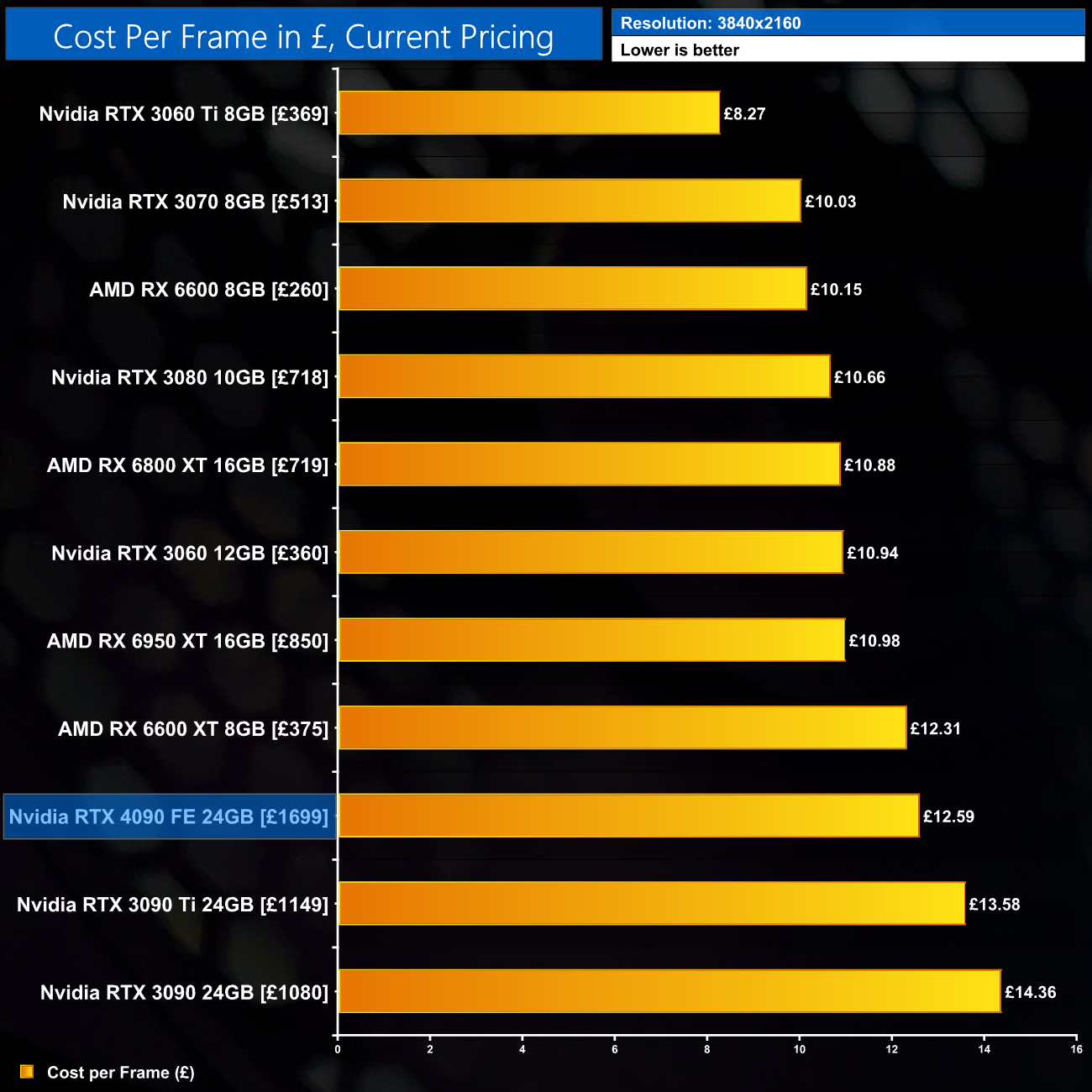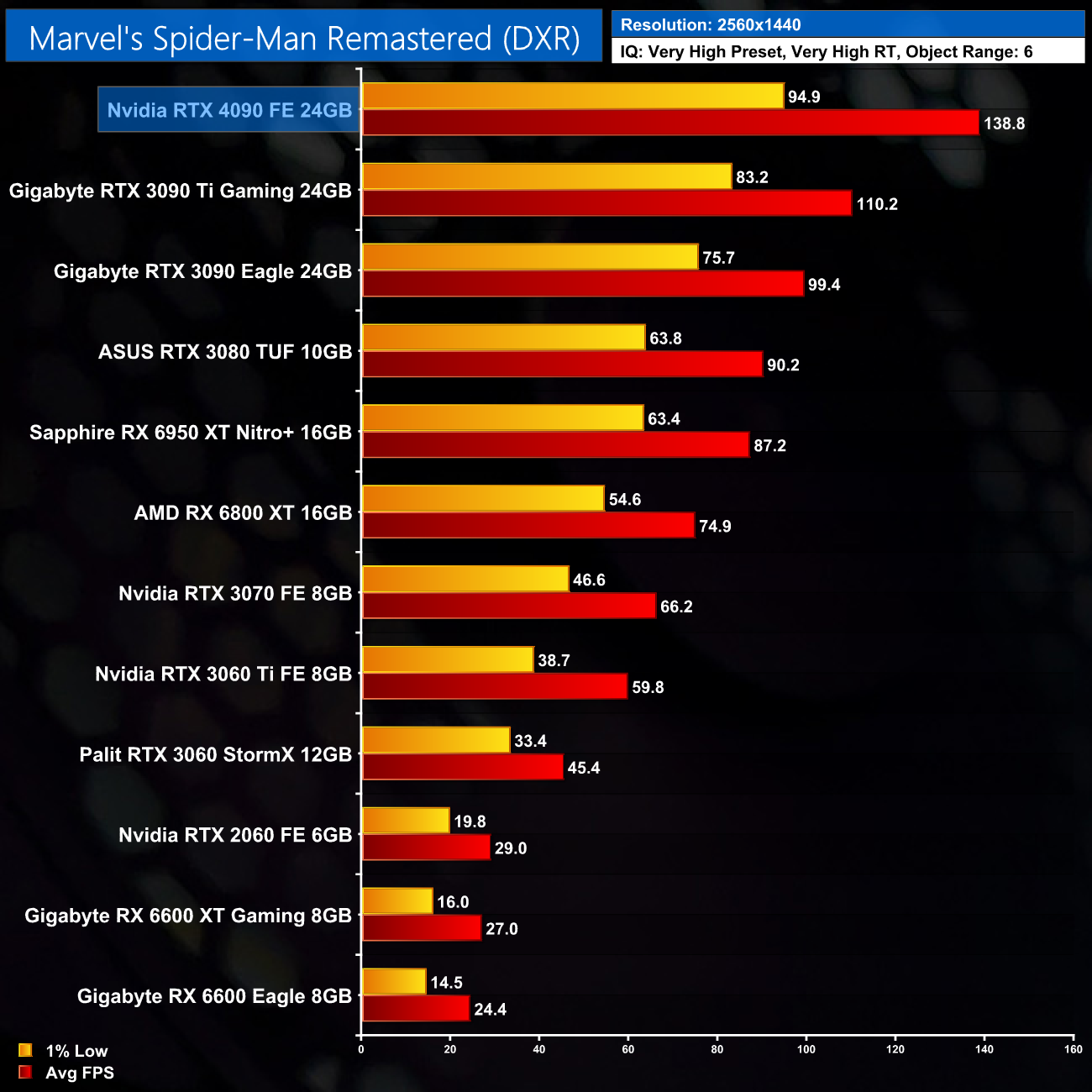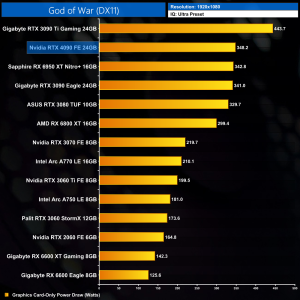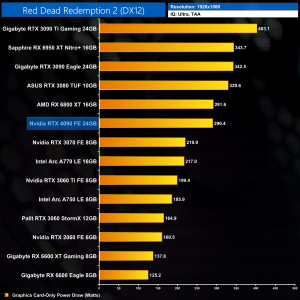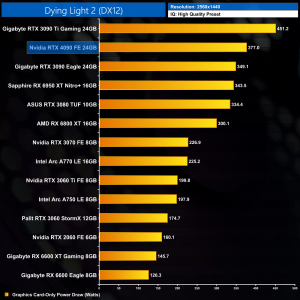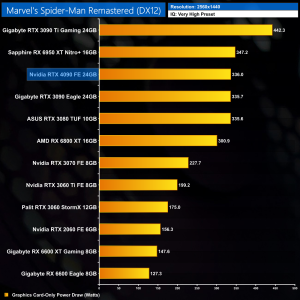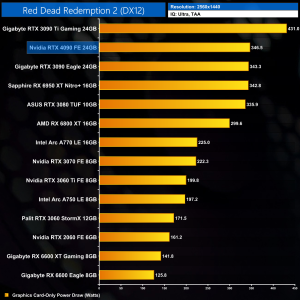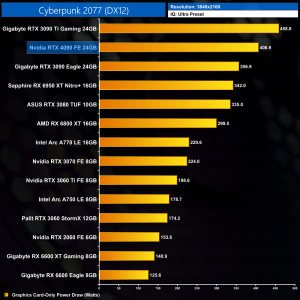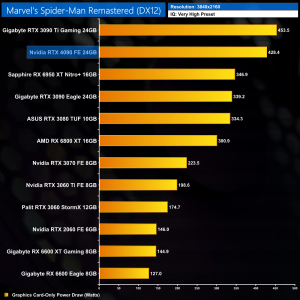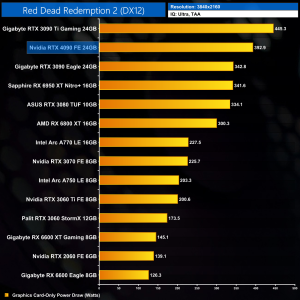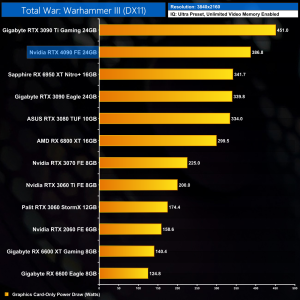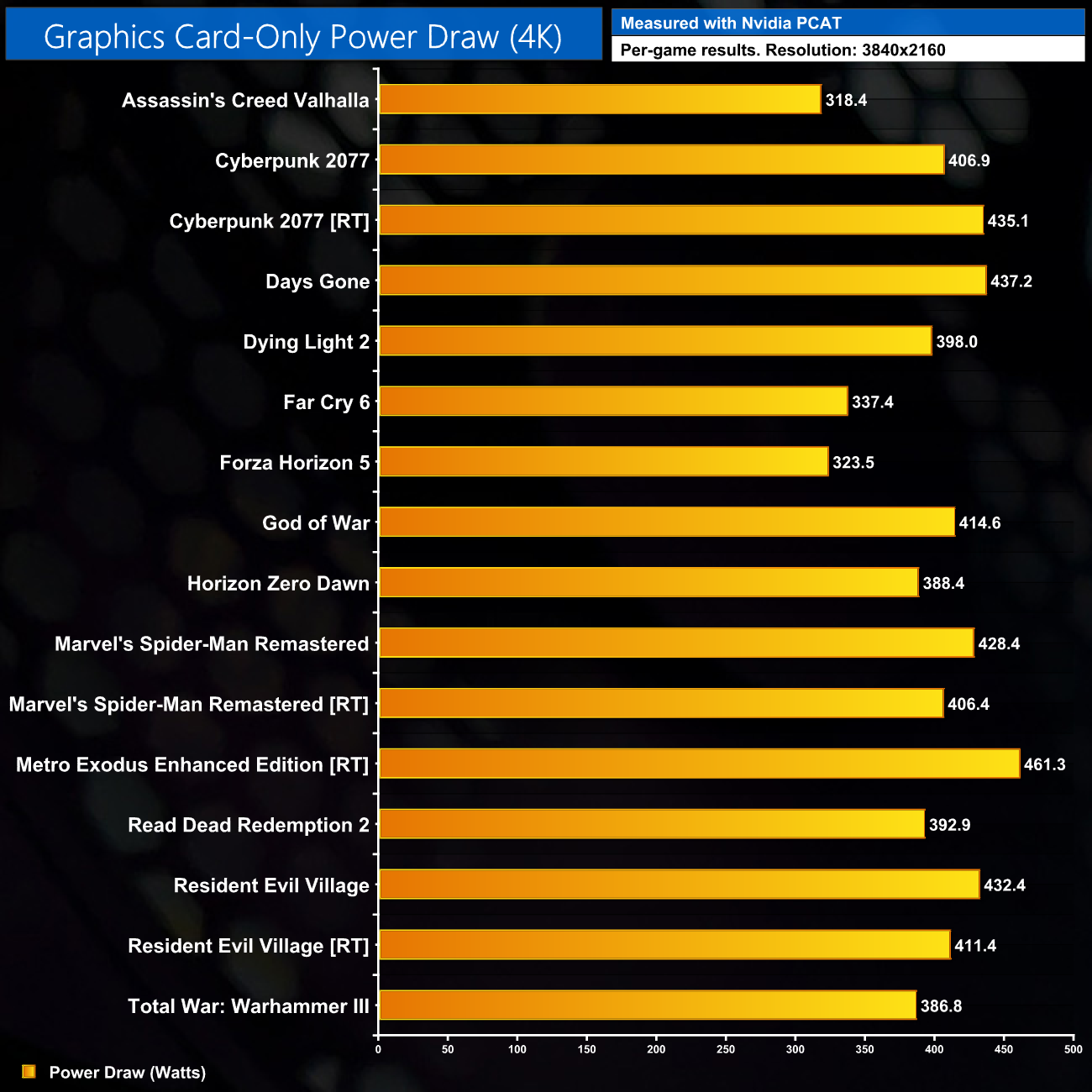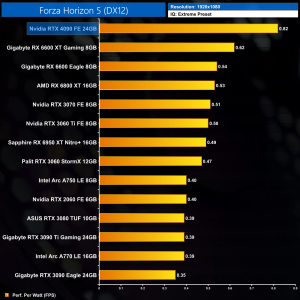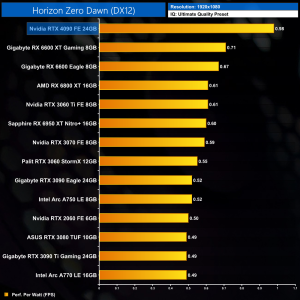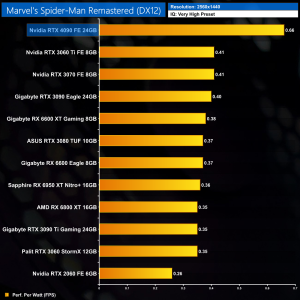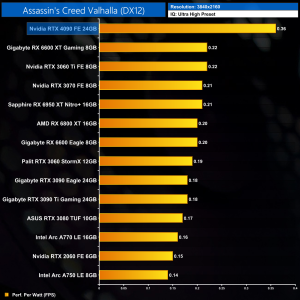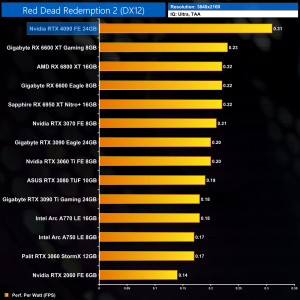
The last two years have felt like an eternity in the graphics card market, with almost the entire GPU generation facing supply shortages, scalper prices and insatiable demand from cryptocurrency miners. Today, however, heralds the start of something new. The next GPU generation is about to kick off, with Nvidia unveiling its Ada Lovelace architecture and RTX 40-series at GTC last month.
We can now present our review of the flagship RTX 4090, packing 76.3 billion transistors, 16384 CUDA Cores and a boost clock that exceeds 2.5GHz…
| RTX 4090 | RTX 3090 Ti | RTX 3090 | RTX 3080 Ti | RTX 3080 | |
| Process | TSMC 4N | Samsung 8N | Samsung 8N | Samsung 8N | Samsung 8N |
| SMs | 128 | 84 | 82 | 80 | 68 |
| CUDA Cores | 16384 | 10752 | 10496 | 10240 | 8704 |
| Tensor Cores | 512 | 336 | 328 | 320 | 272 |
| RT Cores | 128 | 84 | 82 | 80 | 68 |
| Texture Units | 512 | 336 | 328 | 320 | 272 |
| ROPs | 176 | 112 | 112 | 112 | 96 |
| GPU Boost Clock | 2520 MHz | 1860 MHz | 1695 MHz | 1665 MHz | 1710 MHz |
| Memory Data Rate | 21 Gbps | 21 Gbps | 19.5 Gbps | 19 Gbps | 19 Gbps |
| L2 Cache | 73728 KB | 6144 KB | 6144 KB | 6144 KB | 5120 KB |
| Total Video Memory | 24GB GDDR6X | 24GB GDDR6X | 24GB GDDR6X | 12GB GDDR6X | 10GB GDDR6X |
| Memory Interface | 384-bit | 384-bit | 384-bit | 384-bit | 320-bit |
| Memory Bandwidth | 1008 GB/Sec | 1008 GB/Sec | 936 GB/Sec | 912 GB/Sec | 760 GB/Sec |
| TGP | 450W | 450W | 350W | 350W | 320W |
Unlike the launch of the RTX 30-series back in September 2020, where Nvidia kicked off the new generation with the RTX 3080 and then followed it up with the RTX 3090, this time around it is the big boy being released first – the RTX 4090. Two RTX 4080 SKUs are on the way but won't be landing until next month, and after that… well, your guess is as good as mine.
Still, with the RTX 4090, Nvidia hopes to inject new life into the GPU market. Switching from Samsung 8nm to TSMC 4nm has allowed the manufacturer to vastly increase transistor count, up from 28.3 billion with GA102, to a staggering 76.3 billion with the largest Ada GPU, AD102. Accordingly, core count has gone through the roof, with the RTX 4090 home to 16384 CUDA cores, with 512 Tensor cores and 128 RT cores, with a sizeable increase to the ROP count too, up to 176.
Such a leap forward in process node has also allowed Nvidia to crank the clock speed significantly, with the RTX 4090 now sporting a 2520MHz rated boost clock. Most of the Ampere generation ran at around 1800MHz, so that is really quite a generational improvement.
Memory configuration, however, is almost identical to the RTX 3090 Ti, with 24GB GDDR6X running at 21Gbps, operating over 384-bit interface, totalling memory bandwidth of just over 1TB/s. That said, there has been a substantial upgrade to the L2 cache with the Ada architecture, with the RTX 4090 now offering 73MB, compared to 6MB for GA102.
Power draw also remains at 450W, as per the RTX 3090 Ti, but we are using our updated GPU power testing methodology in this review, so read on for our most detailed power and efficiency testing yet.
To view all pages of this review, click HERE.
The Nvidia RTX 4090 Founders Edition ships in a large black box. The front of the box opens up to reveal the card itself, sitting in a cardboard surround.
Inside, a quick-start guide and power supply notes are included, as well as the 4x 8-pin to 12VHPWR adapter.
Taking a look at the card itself, on the face of it, the overall design doesn't appear to have changed much. Nvidia has made a few tweaks however and claims to have improved the overall efficiency of the cooler versus the RTX 3090.
For one, the size of both fans has increased to 120mm – that's right, 120mm fans on a graphics card is a thing now. Nvidia also claims switching to fluid dynamic bearings improves acoustics, while the fans are now ‘counter-rotating'. In practice, this means the fan on the underside of the card spins anti-clockwise, while the fan on the top spins clockwise.
We also can't help but mention just how large this graphics card really is. It measures 304 x 147 x 61mm, so not only is it significantly taller than the PCIe bracket, but it is also a full three slots thick. The weight coming in at just under 2.2KG gives you an idea of the heft of the Founders Edition.
To better illustrate the sheer size of the 4090, in the four images above you can see it pictured next to an RTX 3080 Ti Founders Edition. The 3080 Ti is a 350W GPU that released last year, but you can clearly see how tiny it looks in comparison. The RTX 4090 is not playing about.
The side of the card is fairly plain, with the grey metal frame on show, along with some large aluminium heatsink fins. The GeForce RTX branding is also present here in its new font, and this is illuminated by white LEDs once powered on.
The backplate retains the same x-shaped design as the 30-series, with the RTX 4090 branding visible on the left-hand side. A 120mm fan takes up almost the entirety of the right-hand side.
We already mentioned the new 12VHPWR, or PCIe 5.0, power connector that's positioned on the side of the card.
Display outputs consist of 3x DisplayPort 1.4 and 1x HDMI 2.1, so it's disappointing that there's no DisplayPort 2.0 support here.
Driver Notes
- All AMD GPUs were benchmarked with the public Adrenalin 22.9.1 driver.
- All Nvidia GPUs (except RTX 4090) were benchmarked with the 516.94 driver.
- RTX 4090 was benchmarked with the 521.90 driver supplied to press.
- All Intel GPUs were benchmarked with the 101.3433 driver supplied to press.
Test System:
We test using a custom built system powered by MSI, based on Intel’s Alder Lake platform. You can read more about this system HERE and check out MSI on the CCL webstore HERE.
| CPU |
Intel Core i9-12900K
|
| Motherboard |
MSI MEG Z690 Unify
|
| Memory |
32GB (2x16GB) ADATA XPG Lancer DDR5 6000MHz
CL 40-40-40
|
| Graphics Card |
Varies
|
| SSD |
2TB MSI Spatium M480
|
| Chassis | MSI MPG Velox 100P Airflow |
| CPU Cooler |
MSI MEG CoreLiquid S360
|
| Power Supply |
Corsair 1200W HX Series Modular 80 Plus Platinum
|
| Operating System |
Windows 11 Pro 21H2
|
| Monitor |
MSI Optix MPG321UR-QD
|
| Resizable BAR |
Enabled for all supported GPUs
|
Comparison Graphics Cards List
- Sapphire RX 6950 XT Nitro+ 16GB
- AMD RX 6800 XT 16GB
- Gigabyte RX 6600 XT Gaming OC Pro 8GB
- Gigabyte RX 6600 Eagle 8GB
- Gigabyte RTX 3090 Ti Gaming 24GB
- Gigabyte RTX 3090 Eagle 24GB
- ASUS RTX 3080 TUF Gaming 10GB
- Nvidia RTX 3070 FE 8GB
- Nvidia RTX 3060 Ti FE 8GB
- Palit RTX 3060 StormX 12GB
- Nvidia RTX 2060 FE 6GB
- Intel A770 Limited Edition 16GB
- Intel A750 Limited Edition 8GB
All cards were tested at reference specifications.
Software and Games List
- 3DMark Fire Strike & Fire Strike Ultra (DX11 Synthetic)
- 3DMark Time Spy (DX12 Synthetic)
- 3DMark DirectX Raytracing feature test (DXR Synthetic)
- Assassin's Creed Valhalla (DX12)
- Cyberpunk 2077 (DX12)
- Days Gone (DX11)
- Dying Light 2 (DX12)
- Far Cry 6 (DX12)
- Forza Horizon 5 (DX12)
- God of War (DX11)
- Horizon Zero Dawn (DX12)
- Marvel's Spider-Man Remastered (DX12)
- Metro Exodus Enhanced Edition (DXR)
- Red Dead Redemption 2 (DX12)
- Resident Evil Village (DX12)
- Total War: Warhammer III (DX11)
We run each benchmark/game three times, and present mean averages in our graphs. We use FrameView to measure average frame rates as well as 1% low values across our three runs.
Fire Strike is a showcase DirectX 11 benchmark for modern gaming PCs. Its ambitious real-time graphics are rendered with detail and complexity far beyond other DirectX 11 benchmarks and games. Fire Strike includes two graphics tests, a physics test and a combined test that stresses the CPU and GPU. (UL).
3DMark Time Spy is a DirectX 12 benchmark test for Windows 10 gaming PCs. Time Spy is one of the first DirectX 12 apps to be built the right way from the ground up to fully realize the performance gains that the new API offers. With its pure DirectX 12 engine, which supports new API features like asynchronous compute, explicit multi-adapter, and multi-threading, Time Spy is the ideal test for benchmarking the latest graphics cards. (UL).
There's a new 3DMark chart topper in town! The RTX 4090 stretches well past the likes of the RX 6950 XT and RTX 3090 Ti, outperforming the latter card by 73% in the Time Spy Extreme benchmark. Hopefully that translates into real-world gaming performance.
Real-time ray tracing is incredibly demanding. The latest graphics cards have dedicated hardware that’s optimized for ray-tracing. The 3DMark DirectX Raytracing feature test measures the performance of this dedicated hardware. Instead of using traditional rendering techniques, the whole scene is ray-traced and drawn in one pass. The result of the test depends entirely on ray-tracing performance. (UL).
The 3DMark DXR benchmark is a test of raw ray tracing performance and wow, the 4090 delivers in spades here, offering well over double the performance of the RTX 3090 Ti. Later in this review, we test four different games with ray tracing, but this is a very promising start.
Assassin's Creed Valhalla is an action role-playing video game developed by Ubisoft Montreal and published by Ubisoft. It is the twelfth major instalment and the twenty-second release in the Assassin's Creed series, and a successor to the 2018's Assassin's Creed Odyssey. The game was released on November 10, 2020, for Microsoft Windows, PlayStation 4, Xbox One, Xbox Series X and Series S, and Stadia, while the PlayStation 5 version was released on November 12. (Wikipedia).
Engine: AnvilNext 2.0. We test using the Ultra High preset, DX12 API.
Kicking off the game benchmarks with Assassin's Creed Valhalla, the RTX 4090 delivers 163FPS at 1440p, making it 63% faster than the RTX 3090 Ti. Compared to the RX 6950 XT, the RTX 4090 is less impressive, coming in only 35% faster – though do remember AMD GPUs are particularly strong in this game.
At 4K, the RTX 4090 pulls further away, still managing over 110FPS. This makes it 57% faster than the 6950 XT, 64% ahead of the RTX 3090 Ti and, rather impressively, it's outperforming the vanilla RTX 3090 by 81%.
Cyberpunk 2077 is a 2020 action role-playing video game developed and published by CD Projekt. The story takes place in Night City, an open world set in the Cyberpunk universe. Players assume the first-person perspective of a customisable mercenary known as V, who can acquire skills in hacking and machinery with options for melee and ranged combat. Cyberpunk 2077 was released for Microsoft Windows, PlayStation 4, Stadia, and Xbox One on 10 December 2020. (Wikipedia).
Engine: REDengine 4. We test using the Ultra preset, DX12 API.
The RTX 4090 impresses in Cyberpunk 2077. At 1440p it averages 144PS, once more leading the RTX 3090 by over 80%, and it's over 60% faster than the RTX 3090 Ti and RX 6950 XT.
As we'd expect, however, it really pulls away at 4K, becoming the first GPU to offer a true 4K60 experience in Night City. It's 78% faster than the RX 6950 XT, and still well over 60% faster than the RTX 3090 Ti.
Days Gone is a 2019 action-adventure survival horror video game developed by Bend Studio and published by Sony Interactive Entertainment for the PlayStation 4 and Microsoft Windows. As part of Sony's efforts to bring more of its first-party content to Microsoft Windows following Horizon Zero Dawn, Days Gone released on Windows on May 18, 2021. (Wikipedia).
Engine: Unreal Engine 4. We test using the Very High preset, DX11 API.
As we will see from a few titles on test today, not every game scales as well with the new Ada silicon. Days Gone is one such title, and while performance is still chart-topping, the RTX 4090 is just 35% ahead on average compared to the RTX 3090 Ti, with the 1% lows seeing an even smaller 29% boost.
At 4K things do improve, and the RTX 4090 averages over 145FPS. Compared to Assassin's Creed Valhalla and Cyberpunk though, the 48% improvement over the RTX 3090 Ti doesn't look as impressive, though it's still 70% ahead of the RTX 3090.
Dying Light 2: Stay Human is a 2022 action role-playing game developed and published by Techland. The sequel to Dying Light (2015), the game was released on February 4, 2022 for Microsoft Windows, PlayStation 4, PlayStation 5, Xbox One, and Xbox Series X/S. (Wikipedia).
Engine: C-Engine. We test using the High preset, DX12 API.
Dying Light 2 is a better game for the RTX 4090, where it still delivers over 200FPS at 1440p, coming in 80% faster than the vanilla RTX 3090.
4K really is the place to be though, we still see 120FPS on average and the RTX 4090 is 58% ahead of the RTX 3090 Ti, which is not bad at all.
Far Cry 6 is a 2021 action-adventure first-person shooter game developed by Ubisoft Toronto and published by Ubisoft. It is the sixth main instalment in the Far Cry series and the successor to 2018's Far Cry 5. The game was released on October 7, 2021, for Microsoft Windows, PlayStation 4, PlayStation 5, Xbox One, Xbox Series X/S, Stadia, and Amazon Luna. (Wikipedia).
Engine: Dunia Engine. We test using the Ultra preset, HD Textures enabled, DX12 API.
Far Cry 6 is next and even at 1440p, we see clear signs of CPU bottlenecking in this title. We specifically test actual gameplay, rather than using the built-in benchmark which is typically less GPU-bound, but even so, the RTX 4090 is less than 10% faster than the 3090 Ti, and basically level with the RX 6950 XT.
Stepping up to 4K clearly helps and puts things back in the 4090's favour, but scaling is still towards the lower-end, with a 45% boost over the RTX 3090 Ti. It's certainly not to be sniffed at, but it's not as impressive as something like Cyberpunk 2077.
Forza Horizon 5 is a 2021 racing video game developed by Playground Games and published by Xbox Game Studios. The twelfth main instalment of the Forza series, the game is set in a fictionalised representation of Mexico. It was released on 9 November 2021 for Microsoft Windows, Xbox One, and Xbox Series X/S. (Wikipedia).
Engine: ForzaTech. We test using the Extreme preset, DX12 API.
Moving onto Forza Horizon 5, this is actually the game where we saw the biggest performance uplift for the RTX 4090, relative to its predecessors. At 1440p it romps home with 180FPS on average, already a whopping 65% ahead of the RTX 3090 Ti and 72% ahead of the RTX 3090, and we're not even at 4K yet.
I won't tease you though, the 4K numbers are superb. The RTX 4090 is still delivering 150FPS on average and is now 80% faster than the RTX 3090 Ti. That's a huge performance uplift for the Ada flagship, while the 91% advantage it holds over the vanilla RTX 3090 is equally impressive.
God of War is an action-adventure game developed by Santa Monica Studio and published by Sony Interactive Entertainment (SIE). It was released worldwide on April 20, 2018, for the PlayStation 4 with a Microsoft Windows version released on January 14, 2022. (Wikipedia).
Engine: Sony Santa Monica Proprietary. We test using the Ultra preset, DX11 API.
In God of War, we see decent enough scaling at 1440p, though the 1% lows seem to hit a bit of a wall around the 90FPS mark. I'm not sure if that's down to the scene I test or if it's just a quirk of the game engine, so we'll move on to the 4K results.
Here, the RTX 4090 comes in just shy of the 130FPS mark, and it's 54% faster than the RTX 3090 Ti in terms of the average frame rate, though the 1% lows see a smaller 32% boost.
Horizon Zero Dawn is an action role-playing game developed by Guerrilla Games and published by Sony Interactive Entertainment. The plot follows Aloy, a hunter in a world overrun by machines, who sets out to uncover her past. It was released for the PlayStation 4 in 2017 and Microsoft Windows in 2020. (Wikipedia).
Engine: Decima. We test using the Ultimate Quality preset, DX12 API.
From one formerly PlayStation exclusive to another, Horizon Zero Dawn is fairly middle-of-the-road when it comes to overall scaling with the RTX 4090. Hitting 240FPS at 1440p is no small achievement, though once more the 1% lows do lag behind somewhat.
Up at 4K however the 4090 really shines, and here it comes in 54% ahead of the RTX 3090 Ti, while it leads both the RTX 3090 and RX 6950 XT by just over 70%, so those are certainly solid improvements gen-on-gen.
Marvel's Spider-Man Remastered is a 2018 action-adventure game developed by Insomniac Games and published by Sony Interactive Entertainment. A remastered version of Marvel's Spider-Man, featuring all previously released downloadable content, was released for the PlayStation 5 in November 2020 and for Microsoft Windows in August 2022. (Wikipedia).
Engine: Insomniac Games Proprietary. We test using the Very High preset, DX12 API.
Next we come to a new addition to our test suite, Spider-Man Remastered. This one is quite CPU-heavy, though at 1440p we can see a 44% performance uplift over the 3090 Ti in terms of the average frame rates, though – again – the uplift for the 1% lows is much smaller.
At 4K however, we really see the 4090 stretch its legs. Hitting over 150FPS on average, it storms to a 73% performance advantage over the RTX 3090 Ti, and get this – it's now 98% faster than the RTX 3090, almost twice as fast!
Red Dead Redemption 2 is a 2018 action-adventure game developed and published by Rockstar Games. The game is the third entry in the Red Dead series and is a prequel to the 2010 game Red Dead Redemption. Red Dead Redemption 2 was released for the PlayStation 4 and Xbox One in October 2018, and for Microsoft Windows and Stadia in November 2019. (Wikipedia).
Engine: Rockstar Advance Game Engine (RAGE). We test by manually selecting Ultra settings (or High where Ultra is not available), TAA, DX12 API.
As for Red Dead Redemption 2, I honestly never thought I'd see such high frame rates in this game, but the RTX 4090 hits just shy of 180FPS at 1440p, coming in 52% faster than the RTX 3090 Ti.
At 4K, it is still pushing over 120FPS, where we are looking at a 57% frame rate boost against the RTX 3090 Ti, or 77% when compared to the RTX 3090.
Resident Evil Village is a survival horror game developed and published by Capcom. The sequel to Resident Evil 7: Biohazard (2017), players control Ethan Winters, who is searching for his kidnapped daughter; after a fateful encounter with Chris Redfield, he finds himself in a village filled with mutant creatures. The game was announced at the PlayStation 5 reveal event in June 2020 and was released on May 7, 2021, for Windows, PlayStation 4, PlayStation 5, Xbox One, Xbox Series X/S and Stadia. (Wikipedia).
Engine: RE Engine. We test using the Max preset, with V-Sync disabled, DX12 API.
Resident Evil Village is next and this one scales quite well to very high frame rates, with the RTX 4090 pushing over 320FPS at 1440p. Whether or not you need that sort of performance for a game like this is another matter, but still, the 40% boost over the 3090 Ti isn't bad, though compared to the 6950 XT we're looking at a 34% uplift.
Testing at 4K once more unleashes the 4090, and now it can stretch its lead over the RTX 3090 Ti, with a 66% advantage at this resolution. It's also 92% faster than the RTX 3090, so once more not far off double the performance.
Total War: Warhammer III is a turn-based strategy and real-time tactics video game developed by Creative Assembly and published by Sega. It is part of the Total War series, and the third to be set in Games Workshop's Warhammer Fantasy fictional universe (following 2016's Total War: Warhammer and 2017's Total War: Warhammer II). The game was announced on February 3, 2021 and was released on February 17, 2022.(Wikipedia).
Engine: TW Engine 3 (Warscape). We test using the Ultra preset, with unlimited video memory enabled, DX11 API.
Our last game of the day brings us to Total War: Warhammer III. This is a decent title for the 4090, where it delivers a 54% performance uplift over the 3090 Ti at 1440p.
The scaling isn't much better at 4K though, with another 54% advantage, but that's still a 74% lead over the RTX 3090, and rather impressively it's over twice as fast as the RX 6950 XT.
Here we present frame rate figures for each graphics card, averaged across all 12 games on test today. These figures can disguise significant variations in performance from game to game, but provide a useful overview of the sort of performance you can expect at each resolution tested.
Taking a look at the big picture overview, the RTX 4090 goes straight to the top of the chart as we would expect. At 1440p it delivers an average of 202FPS, and that makes it 48% faster on average compared to the RTX 3090 Ti. Against the RTX 3090, we're looking at a 63% uplift, while it's exactly 50% faster than AMD's current fastest, the RX 6950 XT.
You really do need to be playing at 4K to get the most from the silicon, however. At this resolution, the RTX 4090 can stretch its legs and comes in 60% faster on average compared to the RTX 3090 Ti, a hugely impressive gen-on-gen uplift. It's also 80% faster than the vanilla RTX 3090, quite a staggering figure really considering that GPU was the fastest on the market up until March this year.
It's worth taking a closer look at the comparison between the RTX 4090 and RTX 3090 Ti at 4K. While we see a 60% uplift on average, some games scale significantly better than others, as we can see above. Days Gone and Far Cry 6, for instance, are relatively poor performers, and while there's a good stack of games in that 50-60% range, we do see a couple pushing over 70% versus the 3090 Ti.
As always, we recommend checking out other reviews to get as wide of a sample range as possible. Depending on the games in question, overall performance numbers versus the likes of the RTX 3090 Ti and RX 6950 XT will vary.
The MSRPs
Using the average frame rate data presented earlier in the review, here we look at the cost per frame using the UK MSRP launch prices for each GPU.
We'll start our cost per frame analysis by using the MSRP data. Pricing has been highly volatile over the last two years and these prices have been near-unobtainable, but it could be a useful metric for some.
At 1440p, we see the RTX 4090 costs £8.41 for every frame produced, a reduction of 26% against the RTX 3090, and 36% against the RTX 3090 Ti. As expected given the £1699 asking price, however, numerous GPUs are better value for 1440p gaming, including the 6950 XT.
At 4K, the RTX 4090 does better in relative times, now offering a 32% reduction in cost per frame compared to the RTX 3090, while it's not far off 50% cheaper per frame against the RTX 3090 Ti.
Current retail pricing
The MSRP data really doesn't tell the whole story, however, particularly in the high-end segment where prices have been tumbling for months, and we found the RTX 3090 Ti on sale at £1149 – a massive reduction compared to the £1879 MSRP, likewise for the RTX 3090 which is now available for £1080.
This data changes the picture, with the 4090's 1440p cost per frame matching the RTX 3090 Ti almost exactly, which is clearly less impressive.
The 4090 is best suited for 4K gaming and the cost per frame does get better versus the 3090 Ti at that resolution, but it's still only 7% cheaper per frame based on current retail prices.
Here we test Cyberpunk 2077, using the Ray Tracing: Ultra preset, but with DLSS disabled.
Starting our look at ray tracing performance, the RTX 4090 offers a true next-gen experience in Cyberpunk 2077. At 1440p, with RT set to Ultra, we see an average of 78FPS, head and shoulders above the competition. Compared to Nvidia's previous fastest RTX GPU, the 3090 Ti, the 4090 is 76% faster.
At 4K, where no other GPU can offer a playable experience, the RTX 4090 is able to keep the 1% lows above 30FPS. It's still not a super-smooth experience, but compared to Ampere, this is a huge step forward – we're talking an 82% improvement over the 3090 Ti, and a doubling of performance versus the vanilla RTX 3090.
Here we test Marvel's Spider-Man Remastered, with the in-game ray tracing effects set to Very High, Object Range set to 6.
Next up is Marvel's Spider-Man Remastered, and interestingly enough the scaling is quite poor here with ray tracing enabled. At 1440p, the 4090 is only 26% faster than the 3090 Ti, despite being 44% faster with RT turned off. It turns out we're CPU limited, with the 4090 only seeing about 74% GPU utilisation in our test sequence when RT is enabled.
At 4K we do become GPU-bound, and the performance scaling is much more impressive. With the RTX 4090 pushing 113FPS, the Ada flagship is now 74% ahead of the 3090 Ti, while it holds a 96% advantage over the RTX 3090.
Here we test Metro Exodus Enhanced Edition, with the in-game ray tracing effects set to Ultra.
Metro Exodus Enhanced Edition is next, with this game straight up requiring a DXR-capable GPU to run, with every light source in the game being fully ray-traced. At 1440p, the RTX 4090 stomps through our test sequence, hitting 216 FPS, equalling a 63% uplift versus the RTX 3090 Ti.
At 4K we actually see similar scaling at 1440p, this time with a 64% advantage for the 4090 over the 3090 Ti, and it's 89% faster than the RTX 3090.
Here we test Resident Evil Village, this time testing with the in-game ray tracing effects set to High.
Lastly, we assess Resident Evil Village. Not as intense with its ray tracing features, the RTX 4090 still scales fairly well at 1440p – it's 50% faster than the RTX 3090 Ti, when it was 40% faster with RT turned off.
And at 4K, the 4090 is well clear of the RTX 3090 Ti, this time with a 67% advantage, as it is pushing almost 200FPS with the game fully maxed out.
Here we present the average clock speed for each graphics card while running Metro Exodus Enhanced Edition for 30 minutes. We use GPU-Z to record the GPU core frequency during gameplay. We calculate the average core frequency during the 30-minute run to present here.
We're only able to share data for the RTX 4090 Founders Edition in this review so a bar chart is not particularly useful. Instead, check out the above scatter graph for a real-time plot of the card's operating clock speed and temperature. Over the 30-minute run, the Founders Edition averaged 2683MHz, boosting up initially to 2730MHz before settling down just below the 2.7GHz figure.
For our temperature testing, we measure the peak GPU core temperature under load. A reading under load comes from running Metro Exodus Enhanced Edition for 30 minutes.
We'd expect solid thermal performance from any Nvidia Founders Edition card, and certainly one this gargantuan, so it's good to see the GPU temperature peaked at just 70C during a prolonged stress test in Metro Exodus Enhanced Edition. The hot spot hit 78C, too, well within safe limits, and we also logged the GDDR6X memory junction temperature at a peak of 84C. I look forward to testing a range of partner cards in the coming days to see how they compare!
We take our noise measurements with the sound meter positioned 1 foot from the graphics card. I measured the noise floor to be 32 dBA, thus anything above this level can be attributed to the graphics cards. The power supply is passive for the entire power output range we tested all graphics cards in, while all CPU and system fans were disabled. A reading under load comes from running Metro Exodus Enhanced Edition for 30 minutes.
As for noise levels, the 4090 Founders Edition certainly isn't loud, but it's not as quiet as the likes of the RTX 3070 FE, hitting 41dBa on our sound meter. Default fan behaviour includes asynchronous control of the two fans – fan 1, the one on the bottom of the card that intakes air, ran at 49% speed, or about 1520rpm. Fan 2, meanwhile, being the one on the top of the card, ran at 43%, or about 1395rpm.
I also found the fan on the top to sound just a little bit whiney in its sound profile. It's not a big deal at all but the pitch of the fan did cut across the rest of my case fans on occasion – you can find a sound test in our video on the first page.
Following on from our stock thermal and acoustic testing, here we re-test the operating temperature of the GPU, but with noise levels normalised to 40dBa. This allows us to measure the efficiency of the overall cooling solution as varying noise levels as a result of more aggressive fan curves are no longer a factor.
Reducing fan speed by 2% on each fan saw our 4090 hit 40dBa, with temperatures increasing by a couple of degrees for both the GPU and hot spot. Again, we've no comparisons for this data just yet, but we will do shortly when we are able to test a range of AIB cards.
Here we present power draw figures for the graphics card-only, on a per-game basis for all twelve games we tested at 1080p. This is measured using Nvidia's Power Capture Analysis Tool, also known as PCAT. You can read more about our updated power draw testing methodology HERE.
Per-Game Results at 1080p:
Click to enlarge.
12-Game Average at 1080p:
Graphics card-only power draw paints an interesting picture at 1080p, where the 4090 is rather under-utilised. It drew an average of 277W at this resolution across our testing – be sure to check out the per game results at the top of the page.
Here we present power draw figures for the graphics card-only, on a per-game basis for all twelve games we tested at 1440p. This is measured using Nvidia's Power Capture Analysis Tool, also known as PCAT. You can read more about our updated power draw testing methodology HERE.
Per-Game Results at 1440p:
Click to enlarge.
12-Game Average at 1440p:
Even at 1440p, the real-world power draw of the RTX 4090 is well below its 450W-rated TGP. We do see certain games – including Cyberpunk 2077 and Days Gone – pushing close to 400W, but over all 12 games, the card averaged 333W.
Here we present power draw figures for the graphics card-only, on a per-game basis for all twelve games we tested at 2160p (4K). This is measured using Nvidia's Power Capture Analysis Tool, also known as PCAT. You can read more about our updated power draw testing methodology HERE.
Per-Game Results at 2160p (4K):
Click to enlarge.
12-Game Average at 2160p (4K):
Up at 4K, the RTX 4090 is still not consistently hitting over 400W. Don't get me wrong, power draw is still very high for a single GPU, but the RTX 3090 Ti does draw more power across the board. I wonder how much of this is due to current game engines simply not being designed around such a large, high core-count GPU as the 4090 – only time will tell.
You can clearly see just how much variance there is in power draw from this chart above. This also includes our ray-traced benchmarks, with Metro Exodus Enhanced Edition proving to be the most strenuous load, resulting in 461W power draw. Games which historically don't scale as well – including Assassin's Creed Valhalla and Far Cry 6 – see much lower power figures.
Using the graphics card-only power draw figures presented earlier in the review, here we present performance per Watt on a per-game basis for all twelve games we tested at 1080p.
Per-Game Results at 1080p:
Click to enlarge.
12-Game Average at 1080p:
Moving onto performance per Watt, even at 1080p where the RTX 4090 scales relatively poorly, it is still a new efficiency leader, offering 32% better performance per Watt over the RX 6600 XT. It's light years ahead of the RTX 3090 Ti, too, with almost double the efficiency.
Using the graphics card-only power draw figures presented earlier in the review, here we present performance per Watt on a per-game basis for all twelve games we tested at 1440p.
Per-Game Results at 1440p:
Click to enlarge.
12-Game Average at 1440p:
Performance per Watt at 1440p scales in favour of the RTX 4090. It delivers a 42% improvement over the second-most efficient GPU, the RX 6600 XT, but compared to the RTX 3090 Ti it's 85% more performant per Watt.
Using the graphics card-only power draw figures presented earlier in the review, here we present performance per Watt on a per-game basis for all twelve games we tested at 2160p (4K).
Per-Game Results at 2160p (4K):
Click to enlarge.
12-Game Average at 2160p (4K):
Lastly, at 4K, the RTX 4090 is in a class of its own in terms of efficiency. Its next closest rival is the RTX 3070, but the 4090 is still over 50% more efficient, and that increases to 84% when compared to the RTX 3090 Ti. It is highly impressive how efficient the Ada architecture is, and we'd expect this to only get better on the lower-power SKUs.
We measure system-wide power draw from the wall while running Cyberpunk 2077 for 30 minutes. We do this at 1080p, 1440p and 2160p (4K) to give you a better idea of total system power draw across a range of resolutions, where CPU power is typically higher at the lower resolutions.
Total system power draw hits a peak of around 610W in our testing. This is done in Cyberpunk 2077, and will vary depending on the game, but as we've already seen, the RTX 4090 doesn't draw as much power as the 3090 Ti despite both sharing the same 450W-rated TGP. Either way, Nvidia recommends an 850W PSU at minimum, which seems quite sensible based on our testing.
For our manual overclocking tests, we used MSI Afterburner. Our best results are as below.
With a 260MHz offset, the RTX 4090 saw its average operating clock speed increase from 2683MHz at stock, up to 2971MHz. That was measured over a 30-minute stress test in Metro Exodus Enhanced Edition, but in other 4K workloads, we did see 3015MHz on the core.
The benefits of this overclock varied slightly depending on the workload. Time Spy Extreme and Cyberpunk 2077 only saw 7% and 5% improvements, respectively, but Marvel's Spider-Man Remastered saw FPS increase by 10%, while Resident Evil Village netted 8% gains. Either way, we're not talking massive differences, but we look forward to seeing what can be achieved with a third-party card.
Over two years on since the launch of the Ampere architecture and the RTX 30-series, Nvidia is back with a bang, launching the company's latest flagship – the RTX 4090. Heralded as the ‘ultimate GeForce GPU', RTX 4090 is built on the new Ada Lovelace architecture, offering a number of technological improvements over its predecessors.
There's no other place to start this conclusion than with the sheer generational uplift that is offered by the RTX 4090. For 4K gaming, it is 60% faster on average than the RTX 3090 Ti, and 80% faster on average when compared to the RTX 3090. Up against AMD's current flagship, the RX 6950 XT, it offers 75% better performance.
It may take a while for those numbers to sink in, but to give it some context, the data from my day one RTX 3090 review saw that GPU offer 48% better performance than the previous flagship, the RTX 2080 Ti. Fast forward two years and the RTX 4090 has smashed both the 3090 and 3090 Ti out of the water by an even greater margin.
That level of performance means we were able to drive every single game we tested at 4K60 with ease. In fact, over the 12 games tested, the RTX 4090 produced an average frame rate of 135 FPS at 4K, the worst result being 74 FPS in Cyberpunk 2077.
Speaking of resolutions, there's no doubt in my mind that the RTX 4090 was designed for 4K and above. It is still significantly faster than the RTX 3090 Ti at 1440p, but it doesn't scale as well at the lower resolutions – it's 48% faster on average at 1440p, and just 31% faster on average at 1080p. The reason for this appears to be a combination of both CPU limitations and also the FP32-heavy architecture, something we observed with Ampere but is now exacerbated by Ada, particularly with the RTX 4090 offering 16384 cores.
The move to Ada and the 3rd Generation RT Core design has also seen ray tracing performance come on significantly. Here the RTX 4090 scales even better against the RTX 3090 Ti, offering an 82% uplift in Cyberpunk 2077 using the Ray Tracing Ultra preset, while it's also over twice as fast as the RTX 3090 in Marvel's Spider-Man Remastered when testing at 4K.
While trying to avoid any unnecessary hyperbole, I do think this could be a watershed moment for ray tracing in games, with the performance on offer from the RTX 4090 making ray tracing feel like much less of a compromise between fidelity and frame rates. Even with the RTX 3090 Ti, enabling every single ray-traced effect in certain games could result in an unplayable experience, and while we do need to test a larger quantity of ray-traced games, that looks like much less of a problem for the RTX 4090.
Of course, DLSS 3 aims to make that compromise a thing of the past, but we aren't quite ready yet to pass judgement on the technology just yet, simply due to the time spent on this review alone. Our video review includes a brief comparison with DLSS 3 in Cyberpunk 2077 and it certainly looks very promising based on my early impressions, but a full analysis will have to wait for the near future.
Switching back to the RTX 4090 Founders Edition, the fundamental design hasn't changed since the 30-series, but Nvidia has made a few tweaks to improve overall cooling performance. These include the switch to larger, 120mm fans, fluid dynamic bearings and also the fact that each fan now spins in an opposite direction to the other.
In practice, the card performed very well, hitting a peak temperature of 70C after an extended stress test in Metro Exodus Enhanced Edition – a game where we measured 461W of power draw, so this is about as tough as it gets for GPU load right now. Noise levels are perhaps a touch louder than we might have expected given the very quiet fan profile on the 30-series, but again, this is a 450W GPU so our expectations may need to shift slightly – and it was still far from loud.
Speaking of power draw, this review has utilised our in-depth GPU power testing methodology, so if you want to see power draw figures on a per-game and per-resolution basis, you can find that starting on page 28 of this review. We found that the RTX 4090 consistently operated below its 450W TGP rating, with average power draw hitting 389W at 4K. Certain loads – including Metro Exodus Enhanced Edition and Cyberpunk 2077 with the Ray Tracing Ultra preset – would get us up to 450W of juice, but many titles saw significantly lower power draw.
That's certainly a good thing though and coupled with the sheer horsepower of the AD102 GPU, the RTX 4090 is a new performance per Watt champion, offering overall efficiency that is head and shoulders above the competition. At 4K, the next most efficient GPU we tested is the RTX 3070, and the 4090 offers 50% better performance per Watt than that. Compared to the RTX 3090 Ti and we're talking efficiency gains of 80+% which is quite staggering. That bodes well for the rest of the 40-series line up too, with the lower-power SKUs typically offering even greater efficiency.
On that note, however, if I may add a word of caution – it would be easy to look at the performance numbers in this review and get carried away, but I do want to stress that this article is an RTX 4090 review. In other words, what we say here doesn't necessarily apply to the two RTX 4080 SKUs, or the rest of the currently unrevealed 40-series family.
That's particularly important considering the pricing, as with the RTX 4090 hitting the market at £1699, it is only going to be a viable option for a niche customer – the kind of person who wants the best of the best and doesn't care what it will cost. For the customer who does care about cost per frame and overall value… well, the RTX 4090 certainly isn't for you. Instead, we will have to wait and see what is forthcoming from the rest of the 40-series product line – and let's not forget RDNA 3 which is launching next month.
For now, there's no two ways about it – the Nvidia RTX 4090 is a mightily impressive graphics card, offering a stunning generational uplift over the RTX 3090 and RTX 3090 Ti. If you can afford one, you are in for a real treat – but I'm eager to see what comes next from Nvidia for those who can't justify spending £1699 on a graphics card…
Discuss on our Facebook page HERE.
Pros
- Huge performance uplift versus RTX 3090 Ti and RTX 3090.
- Ray tracing is significantly more viable than with Ampere.
- New performance per Watt champion.
- Power draw is actually lower than the 3090 Ti.
- Founders Edition runs cool and isn’t loud.
- We hit 3GHz once overclocked.
Cons
- Very expensive at £1699.
- Founders Edition is monstrously large.
KitGuru says: We could run out of superlatives to describe the RTX 4090, but we'll keep it short: it's hella fast, and hella expensive.
 KitGuru KitGuru.net – Tech News | Hardware News | Hardware Reviews | IOS | Mobile | Gaming | Graphics Cards
KitGuru KitGuru.net – Tech News | Hardware News | Hardware Reviews | IOS | Mobile | Gaming | Graphics Cards






